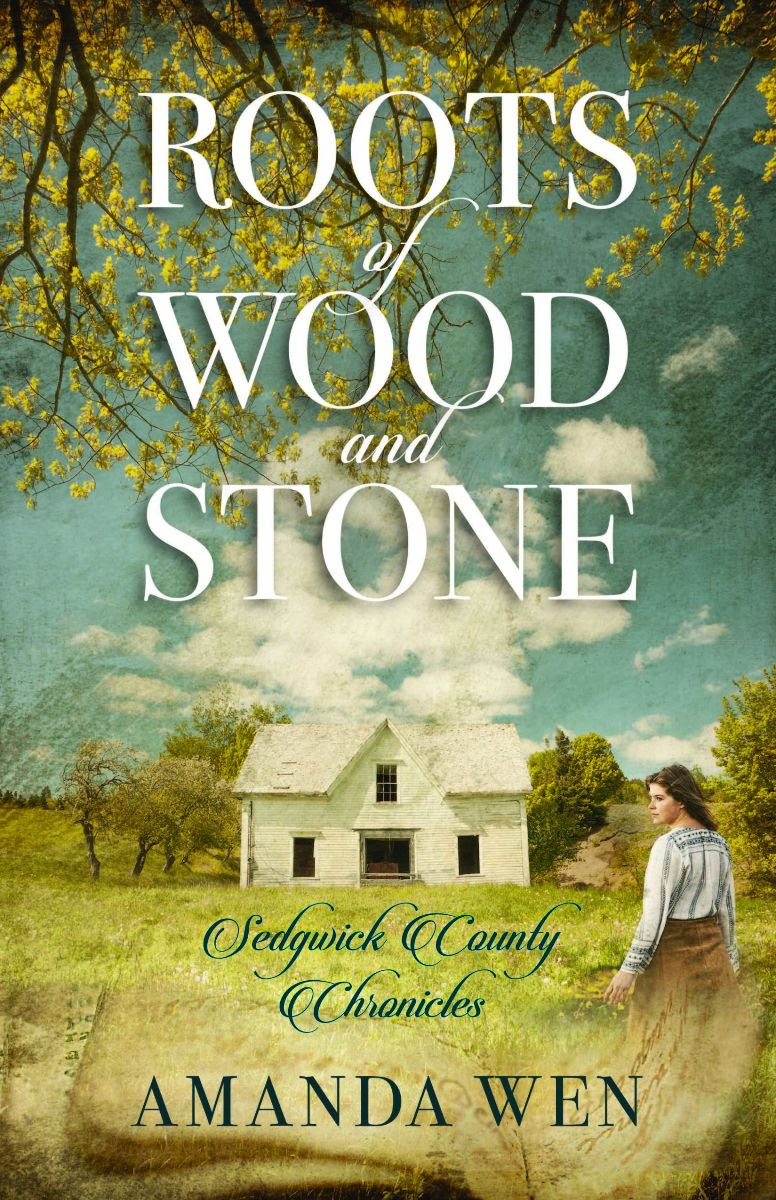| Part 1 of an Interview with Amanda Wen, Author of Roots of Wood and Stone For readers who can’t decide if they would like to pick up something historical or contemporary for their next read, debut author Amanda Wen offers them the best of both worlds in her new release. Roots of Wood and Stone (Kregel Publications) is a warm, delightfully written split-time novel that will resonate with readers looking for stories that reveal the beauty of God’s plan for our lives, and how our actions ripple for generations. |
| Q: What drew you to the split-time genre? What unique challenges does writing in two time periods present? I’ve always loved reading both historical and contemporary books, and I’ve long been a fan of TV shows that hop from era to era. From the ‘80s sci-fi show Quantum Leap and the 2000s crime drama Cold Case to the new hit This Is Us, series like these illustrate in dramatic fashion just how deeply the past impacts the present. Split-time novels do the same thing: characters’ past decisions have ripple effects, both good and bad, for generations to come. In addition, one of my favorite things about split time is watching the contemporary characters dig into the past. My mother is a genealogist who’s been tracing our family history since before I was born, and her passion for uncovering our family’s stories has been an important backdrop my entire life. Her research has given me an appreciation for those who came before and a desire to pass along this appreciation to my own kids. Given all this, I think the split-time genre is a natural fit for me! However, split time doesn’t come without its challenges. Instead of writing one story, I’m writing two, and they have to weave together in an organic way. If you can lift one story line out of the book without hurting the other one, then it’s not integrated well enough. With two stories come two heroes, two heroines, and two plotlines, all of which must be correctly paced and equally interesting to the reader. But challenges aside, Q: How does the historical story connect with the contemporary story? Roots of Wood and Stone revolves around an 1890s farmhouse that is the home of contemporary hero Garrett Anderson’s grandmother, Rosie Spencer. In cleaning out the house, he finds an old satchel which he brings to the local historical museum in hopes that they might have some use for it. The curator, Sloane Kelley, is initially unimpressed with the satchel . . . until she opens it and finds a nineteenth-century diary inside. That diary, written by past heroine Annabelle Collins, links the past time line with the present. As Sloane digs into the diary, she wants to find out more, so she ends up going to the farmhouse to help Garrett and his sister, Lauren, declutter. Subsequent diaries found in the house shine a light on Annabelle’s life as an early settler to Sedgwick County: the love she finds, the losses she suffers, and the God who is faithful to carry her through it all. In addition, these diaries draw Sloane and Garrett together in ways neither could imagine and form the crux of the conflict that arises between the two. Exploring the past has a direct impact on the present for both Sloane and Garrett. Q: Roots of Wood and Stone was inspired by your own family history. Can you tell us a little bit about your family’s story and what parts made their way into your book? The seed of inspiration for Roots of Wood and Stone is an 1890s farmhouse not far from where I grew up (and where I now live) which belonged to my great-great-grandfather, Francis Thomas Little. He immigrated to the United States from Ireland as a child and became one of the earliest settlers of Maize, Kansas. Grandpa Little, as he’s known in my family, wrote a memoir, A Kansas Farmer, which was an invaluable resource during my research process. Francis Little married Mattie Stevens, daughter of another early settler, William Fletcher Stevens, who lost his first wife and infant son shortly after arriving in Sedgwick County in 1870. (In fact, my great-great-great-grandfather would go on to bury a second wife and eight of his fourteen children.) I wondered how someone would cope with such a tragic loss and emerge with his faith intact, and it’s this first early loss that forms the crux of the spiritual journey for my past hero, Jack Brennan. My past heroine, Annabelle Collins, is very loosely based on a paternal ancestor, Antoinette Patrick Peterson, who as a young child was left with an aunt and uncle after the death of her mother. She moved to Kansas with her aunt and uncle, who raised her to adulthood, and I grew curious about the impact of such a decision on a child. The rest of Antoinette’s life was no less interesting and colorful, but I decided to save it for a future book. Q: What did God teach you through the writing of Roots of Wood and Stone? What do you hope your readers take away from the book? Roots of Wood and Stone was my first attempt at split time, and I depended on God for the wisdom to know how to weave the two timelines and stories together. It was an intimidating undertaking, and one possible only through him. Also, trusting God has always been a challenge for me. Like Garrett, I’m a type-A uber planner, one who needs a plan A, plan B, and plan C to feel fully on top of things. While writing this book, I quickly discovered that I could control very little. My characters had their own ideas of how the plot should progress, and the story was frequently better if I let go and trusted them. The publishing journey was no different. Through the very lengthy (and also agonizing) submission process, I had to trust every day that the God who gave me the idea for the story and enabled me to put it on paper would do with it what he chose in the timing that was very best, not only for me but for all who will read the book. As for those readers, I hope they come away with a renewed and restored faith. Though I would never in a million years have chosen to release my debut novel during a global pandemic, I think the message of the book—that God will take all your loose ends and broken pieces and weave them into something more beautiful than you can imagine—is especially timely for such a difficult period in our world. Many of us have been forced to alter the vast majority of our plans this past year, including plans for things—church, work, school, family get-togethers—that we never thought we’d have to alter. But God is still in control. This pandemic has not changed, nor will it change, his good and perfect plan. Q: How did you start writing? How do you balance writing with being a mom and a professional musician? I’ve been writing stories since I could hold a pencil, but it wasn’t until 2008 that the writing bug bit me and refused to let go. This sounds cheesy, but a story idea came to me in a dream one night, and I couldn’t get it out of my head. I wanted to know what happened next, so I did the only thing I could think to do: write the story so I could read it and find out! Over the next few years—interspersed with the births of my three kids—I dabbled in story writing in a couple different genres. In 2014, after my youngest was a year old, I got serious about writing for publication and shared my work with my best friend, who is a multi-published author in the general market. She took me under her wing and corrected all my newbie writing errors, but she also encouraged me and inspired me to write better and better stories. As for how I balance writing with my other life as a professional cellist (playing a lot of freelance gigs, including weddings and the occasional orchestra concert) and pianist (as a choral accompanist for a local middle school and high school), I’ve learned the fine art of prioritizing. During busy music seasons, my writing usually gets put on the back burner. Similarly, when I’m deep in drafting mode or on deadline with revisions, I don’t take on quite so much on the music side. And sometimes I make an intentional choice to take a week or two off from all professional pursuits and focus on my family. Both music and writing feed my soul—as well as feed each other—and they’re both wired so deeply into my DNA that I can’t not do them, so I pray for a lot of wisdom in how to manage my schedule and trust that God will give me the time I need to do what he’s called me to do. Roots of Wood and Stone by Amanda Wen Kregel Publications February 2, 2021 ISBN: 9780825446689 $15.99 |
| About the author |
 Amanda Wen is an award-winning writer of inspirational romance and split-time women’s fiction. She has placed first in multiple writing contests, including the 2017 Indiana Golden Opportunity, the 2017 Phoenix Rattler, and the 2016 ACFW First Impressions contests. She was also a 2018 ACFW Genesis Contest finalist. Amanda Wen is an award-winning writer of inspirational romance and split-time women’s fiction. She has placed first in multiple writing contests, including the 2017 Indiana Golden Opportunity, the 2017 Phoenix Rattler, and the 2016 ACFW First Impressions contests. She was also a 2018 ACFW Genesis Contest finalist.Wen is a member of American Christian Fiction Writers (ACFW) and regularly contributes author interviews for their Fiction Finder feature. She also frequently interviews authors for her blog and is a contributor to the God Is Love blog. Her debut novel, Roots of Wood and Stone, releases from Kregel Publications on February 2, 2021. In addition to her writing, Wen is an accomplished professional cellist and pianist who frequently performs with orchestras, chamber groups, and her church’s worship team. She serves as a choral accompanist as well. A lifelong denizen of the flatlands, Wen lives in Kansas with her patient, loving, and hilarious husband, their three adorable Wenlets, and a snuggly Siamese cat. To find Amanda Wen’s blog and short stories, visit www.amandawen.com. Readers can also follower her on Facebook (@AuthorAmandaWen), Twitter (@AuthorAmandaWen), and Instagram (@authoramandawen). |
-
Sexual Content - 0/5
0/5
-
Violence - 0/5
0/5
-
Language - 0/5
0/5
-
Drugs and Alcohol - 0/5
0/5

